You can Download Samacheer Kalvi 10th Social Science Book Solutions Guide Pdf, Tamilnadu State Board help you to revise the complete Syllabus and score more marks in your examinations.
Tamilnadu Samacheer Kalvi 10th Social Science Geography Solutions Chapter 3 Components of Agriculture
Components of Agriculture Textual Exercise
I. Choose the correct answer.
Question 1.
The soil which is rich in iron oxides is …………
(a) Alluvial
(b) Black
(c) Red
(d) Alkaline
Answer:
(c) Red
![]()
Question 2.
Which of the following organization has divided the Indian soils into 8 major groups?
(a) Indian Council of Agricultural Research
(b) Indian Meteorological Department
(c) Soil Survey of India
(d) Indian Institute of Soil Science
Answer:
(a) Indian Council of Agricultural Research
Question 3.
The soils formed by the rivers are: ……….
(a) Red soils
(b) Black soils
(c) Desert soils
(d) Alluvial soils
Answer:
(d) Alluvial soils
![]()
Question 4.
……………… is the highest gravity dam in india
(a) Hirakud dam
(b) Bhakra Nangal dam
(c) Mettur dam
(d) Nagarjuna Sagar dam
Answer:
(b) Bhakra Nangal dam
Question 5.
……… is a cash crop.
(a) Cotton
(b) Wheat
(c) Rice
(d) Maize
Answer:
(a) Cotton
![]()
Question 6.
Black soils are also called as:
(a) Arid solis
(b) Saline soils
(c) Regur soils
(d) Mountain soils
Answer:
(c) Regur soils
Question 7.
The longest dam in the world is ……..
(a) Mettur dam
(b) Kosi dam
(c) Hirakud dam
(d) Bhakra-Nangal dam
Answer:
(c) Hirakud dam
Question 8.
The leading producer of rice in India is:
(a) Punjab
(b) Maharashtra
(c) Uttar Pradesh
(d) West Bengal
Answer:
(d) West Bengal
Question 9.
Which crop is called as “Golden Fibre” in India?
(a) Cotton
(b) Wheat
(c) Jute
(d) Tobacco
Answer:
(c) Jute
![]()
Question 10.
The state which leads in the production of coffee is:
(a) West Bengal
(b) Karnataka
(c) Odisha
(d) Punjab
Answer:
(b) Karnataka
![]()
II. Consider the given statements and choose the right option given below.
Question 1.
Assertion (A): Horticulture involves the cultivation of fruits, vegetables, and flowers.
Reason (R): India ranks first in the world in the production of mango, banana, and citrus fruits.
(a) Both (A) and (R) are true and (R) explains (A)
(b) Both (A) and (R)are true: (R) does not explain (A)
(a) is correct (R) is false
(d) (A) is false (R) is true
Answer:
(a) Both (A) and (R) are true and (R) explains (A)
Question 2.
Assertion (A): Alluvial soil is formed by the deposition of eroded and decayed materials brought by the rivers.
Reason (R): Paddy and wheat are grown well in the soil.
(a) Both (A) and (R) are true and (R) explains (A)
(b) Both (A) and (R)are true and (R) does not explain (A)
(c) (A) is correct (R) is false
(d) (A) is false (R) is true
Answer:
(d) (A) is false (R) is true
III. Pick the odd one out.
Question 1.
(a) Wheat
(b) Rice
(c) Millets
(d) Coffee
Answer:
(d) Coffee
Question 2.
(a) Khadar
(b) Bhangar
(c) Alluvial soil
(d) Black soil
Answer:
(d) Black soil
Question 3.
(a) Inundational canals
(b) Perennial canals
(c) Tanks
(d) Canals
Answer:
(c) Tanks
![]()
IV. Match the following.

Answers:
1. (d) Uttar Pradesh and Bihar
2. (c) Karnataka
3. (e) Highest dam in the India
4. (a) Mahanadi
5. (b) Golden revolution
V. Answer in brief:
Question 1.
Define soil.
Answer:
- Soil is the upper most layer of the land surface.
- It is composed of minerals, organic matter, living organisms, air and water.
Question 2.
Name the types of soil found in India.
Answer:
- Alluvial Soils
- Black soils
- Red soils
- Laterite soils
- Forest and mountain soils
- Arid and desert soils
- Saline and alkaline soils
- Peaty and marshy soils.
Question 3.
State any two characteristics of black cotton soil.
Answer:
- Black cotton soil are sticky (clayey) when wet and develops cracks when dry.
- Has high degree of moisture retentivity.
![]()
Question 4.
What is Multipurpose project?
Answer:
A comprehensive river valley project which serves a number of purposes simultaneously is called a “Multi purpose project”.
Question 5.
Define Agriculture.
Answer:
Agriculture is the process of producing food for people, fodder for cattle, fibre and many other desired products by cultivation and raising of animals (livestock).
Question 6.
State the types of agriculture practices in India.
Answer:
- Subsistence Farming
- Shifting Agriculture
- Intensive Farming
- Dry Farming
- Mixed Farming Agriculture
- Terrace Cultivation
Question 7.
Name the seasons of agriculture in India?
Answer:
Seasons of agriculture in India:
- Kharif season (June – September)
- Zaid season (April – June)
- Rabi season (October – March)
![]()
Question 8.
Mention the plantation crops of India.
Answer:
Plantation crops are cultivated for the purpose of exports. These are cultivated in large estates on hilly slopes.
Tea, coffee, rubber and spices are the major plantation crops of India.
Question 9.
What do you mean by livestock?
Answer:
- Livestock consists of Cattle, goats, buffaloes, sheeps and pigs. It also includes poultry.
- It is an integral component of the farming system in India due to its multi-functional outputs and contribution to socio-cultural security.
Question 10.
Write a brief note on the categories of fisheries in India.
Answer:
Fisheries in India are a very important economic activity and a flourishing sector with varied resources and potentials. In India, fishing is categorised into two types: they are
1. Marine or Sea Fisheries
2. Inland or Fresh Water Fisheries
1. Marine or Sea Fisheries: It includes coastal, off-shore and deep sea fisheries mainly on the continental shelf upto a depth of 200 m. Among the coastal states, Kerala leads in the marine fish production in India.
2. Inland or Fresh Water Fisheries: Rivers, lakes, canals, reservoirs, ponds, tanks etc. are the sources of fresh water and provide fresh water fisheries. About 50 percent of the country’s total fish production comes from the inland fisheries and Andhra Pradesh is the leading producer in India.
VI. Give reasons.
Question 1.
Agriculture is the backbone of India.
Answer:
More than 50% of Indian population is engaged in agriculture and its allied • industries. 25% of our National Income is from agricultural sector. It is the livelihood for the Indian population. Hence Agriculture is the backbone of India.
Question 2.
Rain water harvesting is necessary.
Answer:
Rain water harvesting is an activity of direct collection and storage of water for our purpose or it can be reached into the ground for withdrawal later.
India experience Tropical monsoon type of climate. It gives a seasonal rainfall. It is not uniform and is highly erratic. Most of the time the rainfall is scanty. Hence it is necessary to save the available rain water.
![]()
Question 3.
Small farms are predominant in India.
Answer:
Most of the farmers in India has only small land holdings and fragmented land due to ancestral property share. Mainly in densely populated areas of intensively cultivated states.
VII. Distinguish between the following.
Question 1.
Rabi and Kharif crop seasons.
Answer:
| S.No. | Rabi | Kharif |
| 1. | Rabi crops are sown in the beginning of the winter (i.e.) in November. | Kharif crops are sown in the beginning of monsoon (i.e.) in June. |
| 2. | The crops are harvested in the beginning of summer (i.e) in March. | The crops are harvested in the early days of November. |
| 3. | Major crops are wheat, tobacco, mustard, pulses, linseed and grains. | Major crops are paddy, maize, cotton, millets, jute and sugarcane. |
Question 2.
Inundational canal and perennial canal.
Answer:
| S.No. | Inundational canal | perennial canal |
| 1. | In this, water is taken out directly from the rivers without making any kind of barrage or dam. | These are developed from perennial rivers by constructing barrage to regulate the flow of water. |
| 2. | These canals are not useful for irrigation. | These canals are useful for irrigation |
| 3. | Punjab has got a large numbers of inundation canals drawing water from sutlej river. | These canals are found in Punjab, Haryana and UP. |
Question 3.
Marine fishing and Inland fishing.
Answer:
| S.No. | Marine fishing | Inland fishing |
| 1. | It includes coastal off-shore and deep sea fisheries mainly on the continent shelf. | Rivers, lakes, canals, reservoirs, ponds, tanks etc. |
| 2. | Kerala leads in the marine fish production in India. | Andhra Pradesh is the leading producer in India. |
Question 4.
Alluvial soils and Black soils.
Answer:
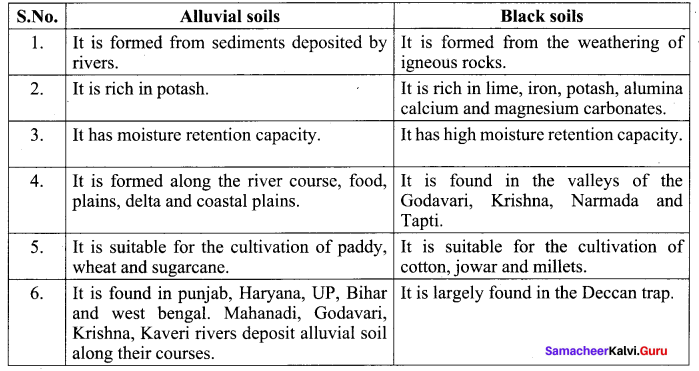
VIII. Answer in a paragraph:
Question 1.
State the types of soil in India and explain the characteristics and distribution of soil.
Answer:
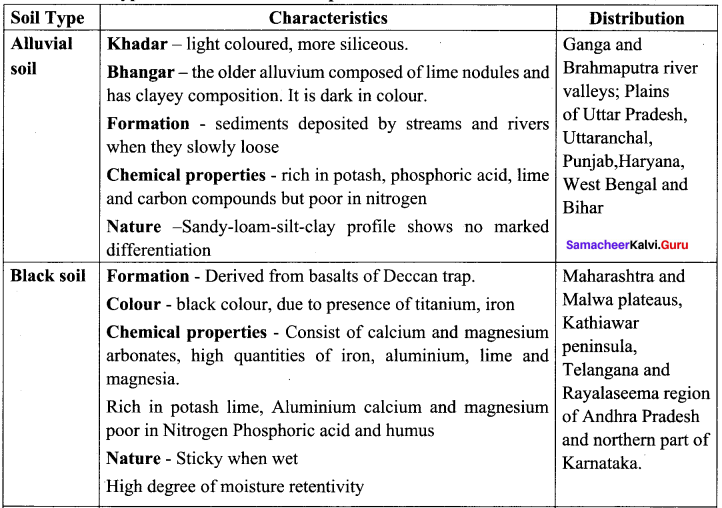
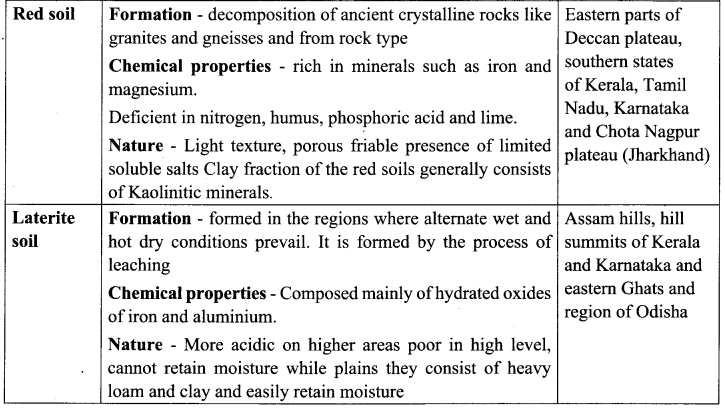

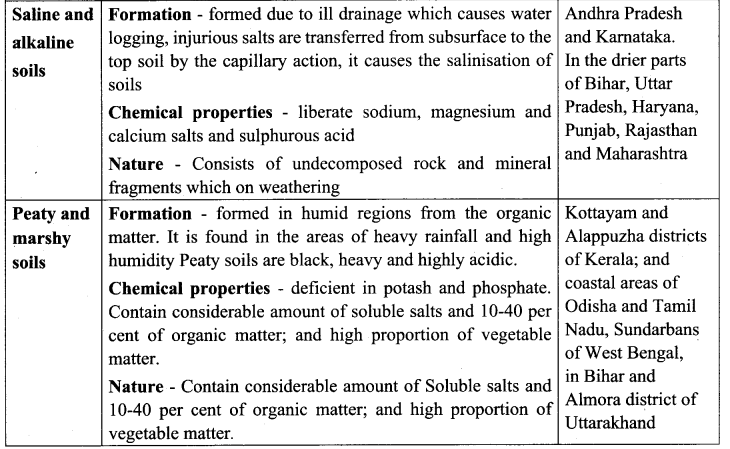
Question 2.
Write about any two Multipurpose projects of India.
Answer:
- Multipurpose project is a scinetific management of water resources in our country.
- Construction of dam across rivers is aimed to serve many purposes such as irrigation, hydro power generation, floods control, water supply for drinking and industrial purpose, development of fisheries, navigation etc.
- In India we have many multipurpose River valley projects.
Bhakra Nangal Project:
- Bhakra Nangal project is the largest and the most important river valley project named after two dams built at Bhakra and Nangal to harness the water of the Sutlej river.
- This dam is the highest gravity dam in the world and forms the Gobmd Sagar Reservoir.
- It irrigates an area of about 52,609 sq.km in the states of Punjab, Haryana and Rajasthan.
- This project generates about 1500 megawatt of Hydropower electricity.
- It is the second tallest dam in Asia with a height of 226 m.
Mettur Dam:
- Mettur Dam has been constructed on the river Kaveri at Salem. The Reservoir behind this dam has been called Stanley Reservoir with a height of 176 ft.
- This project irrigates about 16.5 lakh acres of land in 12 districts of TamilNadu in Kaveri delta basin.
- 40 megawatts hydro power is being produced from this project.
![]()
Question 3.
Bring out the characteristics of Intensive and Plantation farming.
Answer:
Intensive farming:
- It involves various types of agriculture with higher levels of input, such as capital and labour, per unit of agricultural land area.
- It aims to maximize yields from available land through various means, such as heavy use of pesticides and chemical fertilizers.
- Intensive farming is practiced in Punjab, parts of Rajasthan, Uttar Pradesh, and Madhya Pradesh in India.
Plantation farming:
- It is a single crop farming, practised on a large area.
- Crops are mainly grown for the market.
- It is both labour intensive and capital intensive.
- It has an interface of agriculture and industry.
- Developed network of transport and communication connecting the plantation processing industries and markets play an important role in the development of plants. Example-tea, coffee, rubber, sugarcane, etc.
Question 4.
Examine the geographical conditions favourable for the cultivation of rice and wheat.
Answer:
Soil: Deep fertile clayey or loamy soils are suited.
Temperature and Rainfall: Require mean temperatures of 24°C and annual rainfall of 150 cm.
Rice is mainly a tropical crop.
Wheat: Wheat is a temperate or sub-tropical crop. Fertile alluvial soil or mixed soil is ideal for wheat cultivation.
Rainfall: Moderate 50cm – 100cm rainfall.
Temperature: It requires 10°-15°C at the time of sowing and 20°-25°C at the time of ripening.
IX. HOTS Questions.
Question 1.
Can you imagine a world without agriculture?
Answer:
- No, it fs impossible to imagine a world without agriculture.
- Agriculture satisfy the basic need of food to millions of people and live stocks.
- It provide raw materials for agro based industries.
- Export of agricultural produces help in the development of Country’s economy.
![]()
Question 2.
Can you give solutions for the prevailing water disputes in South India (construction of dams / raising of dams / cleaning of tanks)?
Answer:
Dams are meant to mitigate flood and drought by containing water and releasing it as per demand and supply. These days, dams are seen more as hydropower generators. However, in some cases, the price paid to construct a dam, especially in social and environmental terms, becomes too high. Instead of building new dams, we should attend to underperformance of existing ones. For irrigation purposes, we can revive traditional community-managed networks and recharge underground aquifers through rainwater.
We can use technology and develop adaptive farming techniques. Mathematical models can be developed to estimate the water availability in the river based on the rain estimation of the particular year. For example, if estimation says that there won’t be much rain in the particular year then the farmers can be advised to grow oil seeds, millets, etc. If good rains are predicted then the farmers can grow sugarcane, paddy, etc.
The improper use and management of water also add to the water crisis. Pollution and mining of riverbeds are irreversibly transforming riverine ecosystems. In many regions, excessive groundwater pumping has lowered water tables and worsened the problems. The solution lies in reversing environmental degradation, ensuring equitable allocation of water, and minimising disputes on the use of rivers. The health of any waterscape is fundamental to the well-being, lives and livelihoods of communities that depend on it.
X. Map exercise
1. Demarcate the major tracts of alluvial soils.
2. Delineate the main regions of black soil.
6. Demarcate the regions of desert soil.
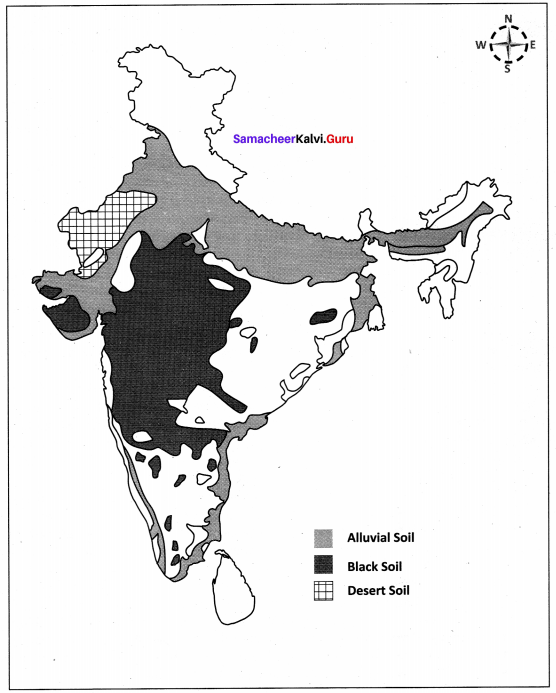
4. Shade the regions of jute cultivation.
5. Mark any three tea and coffee growing areas.
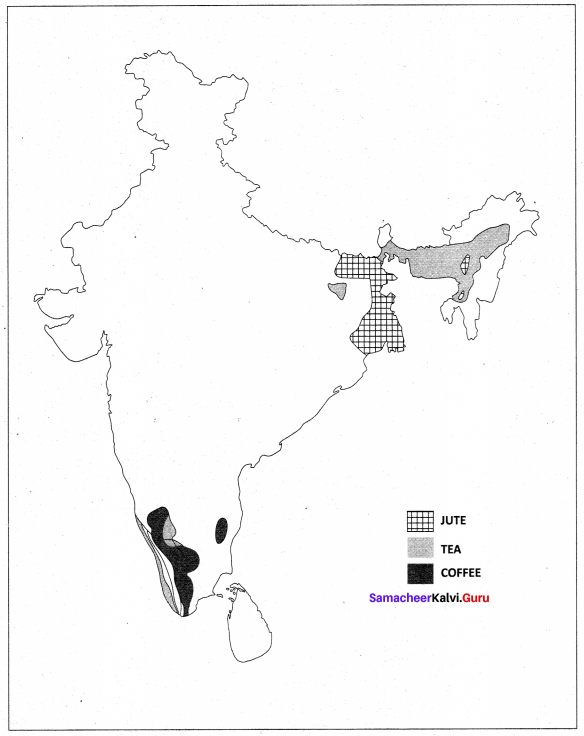
3. Locate the Hirakud dam, Mettur dam and Damodar dam.
7. Locate the fishing hubs: Tuticorin, Chennai, Cochin, Mumbai, Machilipatnam
8. Demarcate: Cauvery delta, Godavari delta
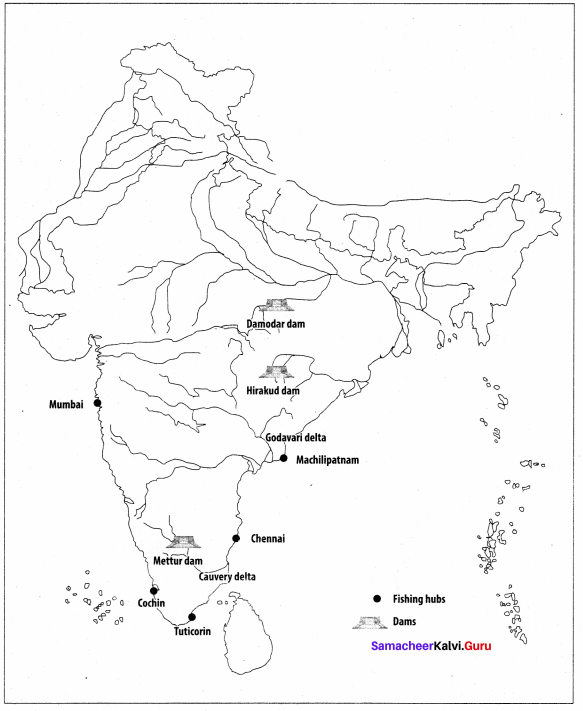
Components of Agriculture Additional Questions
I. Choose the correct answer.
Question 1.
Paddy is grown well in the ……….
(a) black soil
(b) laterite soil
(c) alluvial soil
Answer:
(c) alluvial soil
![]()
Question 2.
……………… soils are formed due to ill drainage.
(a) Mountain
(b) Saline and alkaline
(c) Peaty
(d) Desert
Answer:
(b) Saline and alkaline
Question 3.
The predominant types of Indian agriculture is …….
(a) commercial agriculture
(b) subsistence agriculture.
(c) primitive agriculture
Answer:
(b) subsistence agriculture.
Question 4.
The effective source of irrigation in areas of low level relief is ……………… irrigation.
(a) Canal
(b) Tank
(c) Well
(d) Lakes
Answer:
(a) Canal
![]()
Question 5.
Black soils are ideal for the cultivation of
(a) Rice
(b) Jute
(c) Cotton
Answer:
(c) Cotton
Question 6.
……………… is the leading state in tank irrigation.
(a) Tamil Nadu
(b) Karnataka
(c) Andhra Pradesh
(d) Telangana
Answer:
(a) Tamil Nadu
![]()
Question 7.
The staple food of South Indian is ………
(a) Rice
(b) Wheat
(c) Millets
Answer:
(a) Rice
Question 8.
……………… River valley project is a joint venture between Bihar and Nepal.
(a) Kosi
(b) Damodhar
(c) Bhakranangal
(d) Tungabhadra
Answer:
(a) Kosi
Question 9.
One of the important Kharif crops is ………..
(a) Barley
(b) Cotton
(c) Vegetables
Answer:
(b) Cotton
![]()
Question 10.
The name of the shifting agriculture followed by the tribals of Odisha and Andhra Pradesh is:
(a) Jhum
(b) Podu
(c) Poonam
(d) Penda
Answer:
(b) Podu
Question 11.
In Kerala ………….. has many coffee estates.
(a) Kochi
(b) Wynad
(c) Trivandrum
Answer:
(b) Wynad
Question 12.
The leading state in wool production is ……………… with 32.9%
(a) Karnataka
(b) Jammu and Kashmir
(c) Rajasthan
(d) West Bengal
Answer:
(c) Rajasthan
![]()
Question 13.
The ……… is known as Sorrow of Bihar.
(a) Krishna
(b) Damodar
(c) Kosi
Answer:
(c) Kosi
Question 14.
The Periyar river has its source in the state of ……..
(a) Tamil Nadu
(b) Karnataka
(c) Kerala
Answer:
(c) Kerala
Question 15.
There is demand for additional farm labour due to ……….
(a) irrigation
(b) rainfall
(c) electrification
Answer:
(a) irrigation
![]()
Question 16.
To areas of small holidays …….. irrigation is well suited.
(a) well
(b) tubewell
(c) canal
Answer:
(b) tubewell
Question 17.
The ……… dam is constructed on the river Beas.
(a) Bakra Nangal
(b) Pong
(c) Mettur
Answer:
(b) Pong
Question 18.
The Kosi project in Bihar has been taken up in co-operation with ………
(a) Nepal
(b) Bhutan
(c) Thailand
Answer:
(a) Nepal
Question 19.
The Mettur dam irrigates Coimbatore and ………. district.
(a) Thanjavur
(b) Tiruchy
(c) Salem
Answer:
(c) Salem
![]()
Question 20.
Lower Bhavani project is located in ………….. district.
(a) coimbatore
(b) Tiruchy
(c) Salem
Answer:
(a) coimbatore
II. Fill in the blanks.
1. The Prime source of water is ……….
2. Canals taken out from reverse without regulating system are called ……… canals.
3. Shifting agriculture is performed by ……… people.
4. The most widely distributed source of irrigation in India is ……….
5. The highest gravity dam in the world is the ……..
6. The longest irrigation canal in the world is ………..
7. The longest dam in the world is the ………. dam.
8. The Cauvery delta canal system belongs to the …….. era.
9. The Bhavani river is one of the tributaries of the ………
10. The two important fibre crops are …….. and ………..
11. A Coffee research center is located at ……….
12. Topography of India favours ………. type of climate.
13. Dry farming mainly depends on ………..
14. Dual cropping is otherwise known as ………
15. As an impact of ………. the production of wheat has been increased in Punjab and Haryana.
16. The major cash crop is ………..
17. Coffee is a ……… crop.
18. Rubber plantation were first established in ……… in 1902.
19. ………. is the leading state in the wool production.
20. At the time of natural calamities farmers are helped by …….. scheme.
Answers:
1. rainfall
2. inundation
3. tribal
4. wells
5. Bhakra Nangal dam
6. Rajasthan canal
7. Hirakud
8. Pre-christian
9. cauvery
10. cotton, jute
11. Yercaud
12. monsoon
13. irrigation
14. double cropping
15. Green revolution
16. sugar cane
17. beverage
18. Kerala
19. Rajasthan
20. crop insurance
III. Match the following.

Answers:
1. (d)
2. (a)
3. (e)
4. (c)
5. (b)

Answers:
1. (c)
2. (e)
3. (d)
4. (a)
5 .(b)

Answers:
1. (b)
2. (e)
3. (d)
4. (a)
5. (c)

Answers:
1. (c)
2. (d)
3. (e)
4. (b)
5. (a)

1. (e)
2. (d)
3. (a)
4. (c)
5. (b)

Answers:
1. (c)
2. (d)
3. (a)
4. (e)
5. (b)
IV. Answer in one word.
Question 1.
What are the determinant factors of agriculture?
Answer:
- Physical factor
- Institutional factors
- Infrastructural factors
- Technological factors
Question 2.
Name the types of farming.
Answer:
- Subsistence farming
- Shifting agriculture
- Intensive farming
- Dry farming
- Mixed fanning agriculture
- Terrace cultivation
![]()
Question 3.
Why and where millets are cultivated?
Answer:
Millets are cultivated in poor soils. They are rich in nutritional content higher when wheat or rice. They also provide fodder for cattle. They grown in almost all the states in India.
Question 4.
Name the Cotton growing areas of India.
Answer:
Gujarat, Maharashtra, Andhra pradesh, Karnataka, Tamil Nadu, Madhya Pradesh, Punjab and Haryana.
Question 5.
What are plantation crops?
Answer:
- Tea
- Coffee
- Rubber
Question 6.
Name the oil seeds of India.
Answer:
Ground nut, sesamum, rape seed, mustard, sunflower seed, castor seed, coconut, soyabean etc.
![]()
Question 7.
What are the natural conditional required for the cultivation of cotton?
Answer:
- Cotton grows well in tropical and subtropical climate.
- Black soil is the most suitable soil for cotton cultivation.
Question 8.
What are the crops grown in rabi for cotton cultivation?
Answer:
Wheat, barley, gram and oil seeds.
Question 9.
Name the jute producing states in India.
Answer:
West Bengal, Bihar, Assam, Orissa and Meghalaya.
Question 10.
Mention the different methods of rice cultivation.
Answer:
Drilling, dibbling and transplanting.
Question 11.
What is ginning?
Answer:
The seeds are separated from the cotton fibre by means of a process called ginning.
![]()
Question 12.
Why is jute called the “ Golden fibre” of India?
Answer:
Jute is called the Golden fibre of India because India earns valuable foreign exchange by exporting jute.
Question 13.
How is Bio-Technology useful in agriculture?
Answer:
Adopting Bio-Technology is environmentally safe and sustainable, cost of production of the farmers will be decreased.
Question 14.
Name the major crops of India.
Answer:
- Food crops
- Cash crops
- Plantation crops
- Horticulture
Question 15.
Who is the largest production of rice in the world?
Answer:
China
![]()
Question 16.
What are the two types of canals?
Answer:
- Inundation canals
- Perennial canals
Question 17.
What is Animal husbandry?
Answer:
It is the art of rearing animals for milk, skin, hide and horns and farm works.
Question 18.
Name the leading wool production areas in India.
Answer:
- Rajasthan
- Jammu and Kashmir
- Karnataka
Question 19.
Name some important varieties of fishes.
Answer:
Cat fish, Herrings, Mackerels, Perches, Eels, Mullets etc.
![]()
Question 20.
Name the top five fish producing states of India.
Answer:
- Andhra Pradesh
- West Bengal
- Gujarat
- Kerala
- Tamil Nadu
Question 21.
Name the important multipurpose projects of India.
Answer:
- Damodar valley project
- Bhakra-Nangal project
- Hirakud project
V. Distinguish Between:
Question 1.
The Khadar and Bhangar
Answer:
| S.No. | Khadar | Bhangar |
| 1. | Khadar is the newer alluvium. | Bhangar is the older alluvium. |
| 2. | It is sandy. | It is light coloured soil. It is clayey in nature. |
Question 2.
Well irrigation and Tube well irrigation.
Answer:
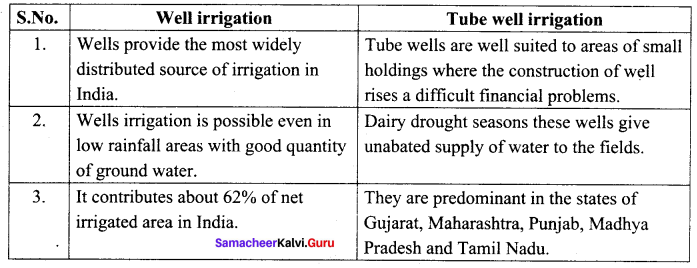
Question 3.
Unicropping and Dual cropping
Answer:

Question 4.
Food crops and Cash crops
Answer:

Question 5.
Wet farming and Dry farming
Answer:

Question 6.
Horticulture and Animal husbandry.
Answer:

VI. Answer in brief.
Question 1.
Name the crops that are grown in alluvial soil.
Answer:
Rice, Wheat, Sugarcane and Oilseeds are mainly grown in alluvial soil.
Question 2.
Explain how land forms influence the pattern of agricultural.
Answer:
The major relief features are mountains, plateaus and plains. Among them, the plains with abundant alluvial soil determines the agricultural productivity. Ex: North Indian Plain, Coastal plains and deltaic plains of South India favour agriculture activity paddy and wheat are the main crops cultivated this region.
![]()
Question 3.
Name the factors on which the sources of irrigation depend?
Answer:
Sources of Irrigation depend upon the following factors: Topography, soil, rainfall, availability of surface or ground water, nature of river and requirements of crops.
Question 4.
Write about drip system.
Answer:
Drip system is used to watering like drops at near the root of plant. It will cover a tiny area at plant, but suitable for big trees and horticulture plant too which used to grow bigger.
Question 5.
What is a tank?
Answer:
A tank is a natural or man-made hollow on the surface developed by constructing a small bund around it across a stream.
![]()
Question 6.
What is mixed farming agriculture?
Answer:
Mixed farming is defined as a system of farm which includes crops production, raising, livestock, poultry, fisheries, bee keeping etc. to sustain and satisfy as many needs of the farmer as possible.
Question 7.
What are the three methods of sowing rice in India?
Answer:
Rice in India is sown in three ways namely:
- Broadcasting
- Ploughing or drilling
- Transplanting
Question 8.
Name the different breeds of Indian cattle.
Answer:
- Milch Breed
- Draught breed and
- Mixed or General breed.
VII. Answer in a paragraph.
Question 1.
What are the main problems faced by the Indian soils? How can we conserve soil?
Solution:
- Soil degradation is an acute problem in India.
- The main reasons are:
- Soil erosion
- Waterlogging
- Saline and Alkaline due to dry climate.
- Deforestation and use of excessive fertilizers.
Methods of Conservation and Management of soil:
In order to retain the fertility and to prevent soil from erosion the following conservation methods can be useful.
- Afforestation
- Constructing Dams and Barrages
- Prevention of overgrazing
- Improved methods of Agricultural practices namely:
- Contour ploughing
- Rotation of crops
- Strip cropping
- Planting shelterbelts
- Adopting techniques of sustainable agriculture for better soil management.
Question 2.
Write a brief account on Damodar valley project.
Answer:
Damodar valley project sets an example towards managing our water resources on scientific lines. Damodar though a small river, was called the “river of sorrow’’ owing to devastating floods it caused. It flows from Chotanagpur in south Bihar, to West Bengal. This project consists of series of small dams on the tributaries of Damodar. There are few hydel power stations st Tilaya, Konar Naithon and Panchet. They have been integrated in a common grid for the growing industrial complexes around South East Bihar and West Bengal. It irrigates half a million hectares of land in parts of South Bihar and West Bengal.
![]()
Question 3.
Name the oil seeds grown in India and its areas of production. How oil seeds are commercially important?
Answer:
Oil seeds are the vital source of fat in Indian diet obtained from number of crops like ground nut, linseed, mustard, grape seed, sesame, sunflower, castor seeds, cotton seeds etc.
Uses: They are commercially important too. Since they provide oil and oil cakes which are used for making lubricants, varnish, medicine, perfume, candles, soap, manure and cattle feed.
Areas of production: Gujarat is the largest producer of oil seeds. Other major producer of oil seeds are Rajasthan, Madhya Pradesh, Maharashtra and Andhra Pradesh.
Question 4.
Write about the Cash crops in India.
Answer:
The crops which are cultivated for commercial purposes are called Cash crops. These crops include sugarcane, tobacco, fibre crops (cotton jute and mesta) and oil seeds.
1. Sugar cane:
Sugar cane is the most important cash of India and is the second largest producer in the world. It provides raw materials for the sugar industry which is the second largest industrial category of our country. Besides providing sugar, gur and Khandsari, it supplies molasses for alcohol industry and bagasse for paper industry. India is ranked Cuba and Brazil. Uttar Pradesh is the leading producer of sugar cane followed by Maharashtra, Karnataka, Tamil Nadu and Gujarat.
2. Cotton:
Cotton is the most important cash crop of India. It provides raw material to the largest industry of India. India ranks second next to China in the production of cotton. 79% of the total area and production in the country were contributes by Gujarat, Maharashtra, Andhra pradesh and Punjab.
3. Jute:
It is a tropical crops, grows well in the alluvial soil. It provides raw material for jute industry. It is used for manufacturing of gunny bags, carpets, lessian, ropes and strings, rugs, clothes, tarpaulins, upholstery etc. West Bengal is the leading state both in cultivation and production. Oil seeds
4. Oil seeds:
Oil seeds, the premier source of fat in the Indian diet are derived from number of crops like groundnut, grapes seed, mustard, sesame, linseed, sunflower, castor seed, cotton seed, nigar seed etc. Gujarat is India’s largest oilseeds producing state. Others are Rajasthan, MP, Maharashtra and Andhra Pradesh. In groundnut production, India is the second largest producer in the world after China.